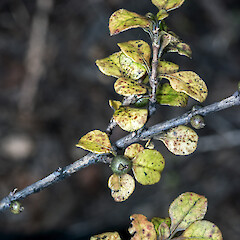Coprosma spathulata subsp. spathulata
Synonyms
None (first described in 1839)
Family
Rubiaceae
Flora category
Vascular – Native
Endemic taxon
Yes
Endemic genus
No
Endemic family
No
Structural class
Trees & Shrubs - Dicotyledons
NVS code
The National Vegetation Survey (NVS) Databank is a physical archive and electronic databank containing records of over 94,000 vegetation survey plots - including data from over 19,000 permanent plots. NVS maintains a standard set of species code abbreviations that correspond to standard scientific plant names from the Ngä Tipu o Aotearoa - New Zealand Plants database.
COPSSS
Chromosome number
2n = 44
Current conservation status
The conservation status of all known New Zealand vascular plant taxa at the rank of species and below were reassessed in 2017 using the New Zealand Threat Classification System (NZTCS) – more information about this can be found on the NZTCS website. This report includes a statistical summary and brief notes on changes since 2012 and replaces all previous NZTCS lists for vascular plants.
Please note, threat classifications are often suggested by authors when publications fall between NZTCS assessment periods – an interim threat classification status has not been assessed by the NZTCS panel.
- Conservation status of New Zealand indigenous vascular plants, 2017 . 2018. Peter J. de Lange, Jeremy R. Rolfe, John W. Barkla, Shannel P. Courtney, Paul D. Champion, Leon R. Perrie, Sarah M. Beadel, Kerry A. Ford, Ilse Breitwieser, Ines Schönberger, Rowan Hindmarsh-Walls, Peter B. Heenan and Kate Ladley. Department of Conservation. Source: NZTCS and licensed by DOC for reuse under the Creative Commons Attribution 4.0 International licence.
2017 | Not Threatened
Previous conservation statuses
2012 | Not Threatened
2009 | Not Threatened
2004 | Not Threatened
Brief description
Bushy shrub with wide-angled twigs bearing pairs of rounded leaves with a long dark flattened leaf stalk inhabiting the northern North Island. Twigs fuzzy. Leaf tip often dented and with very small hairs (lens needed). Small dark tooth on stem between leaf bases. Fruit dark red or black.
Distribution
Endemic. Confined to the North Island where it occurs from Te Paki south to Waitomo in the west and near Gisborne in the east
Habitat
Coastal to montane forest. Mostly in coastal to lowland forest. In the northern part of its range often associated with kauri and kauri-mixed hardwood forest. However it also grows in secondary regrowth under manuka (Kunzea ericoides s.l.) and kahikatoa (Leptospermum scoparium s.l.) and in scrub. It is also often found in alluvial and riparian forests.
Wetland plant indicator status rating
Information derived from the revised national wetland plant list prepared to assist councils in delineating and monitoring wetlands (Clarkson et al., 2021 Manaaki Whenua – Landcare Research Contract Report LC3975 for Hawke’s Bay Regional Council). The national plant list categorises plants by the extent to which they are found in wetlands and not ‘drylands’. The indicator status ratings are OBL (obligate wetland), FACW (facultative wetland), FAC (facultative), FACU (facultative upland), and UPL (obligate upland). If you have suggestions for the Wetland Indicator Status Rating, please contact: [Enable JavaScript to view protected content]
UPL: Obligate Upland
Rarely is a hydrophyte, almost always in uplands (non-wetlands).
Detailed description
Erect, shortly branched to almost fastigiate shrub up to 2 m tall, branches and branchlets slender, widely spreading, divergent, finely and harshly pubescent (rugose). Petioles 7-15 mm long, broadly and prominently winged. Stipules narrow-triangular, obtuse, somewhat ciliolate, denticle prominent. Lamina thick to almost fleshy, coriaceous, glabrous, ± glossy, 10-20 × 10-20 mm, dark green above, usually mottled with yellow or pale green and often streaked or blotched purple, paler below, spathulate, orbicular to broad-oblong, truncate to emarginate or retuse, sometimes apiculate, abruptly narrowed to petiole. Midrib and principal veins evident, reticulations usually obscure. Flowers solitary or paired, terminal on arrested branchlets. Male flower with long linear calyx-teeth; corolla tubular, lobes ovate, acute, > tube. Female flower with 4-5 acuminate calyx-teeth; corolla tubular, lobes narrow, acuminate, > tube. Drupe 6-8 mm long, black, sometimes dark orange or red, globose to subglobose (very rarely oblong).
Manaaki Whenua Online Interactive Key
Similar taxa
Coprosma spathulata subsp. spathulata is very close to C. spathulata subsp. hikuruana. However that subspecies is confined to the ultramafic rocks of the Surville Cliffs and North Cape Plateau, where subsp. spathulata does not occur. It differs from subsp. spathulata by its prostrate, widely trailing growth habit, and dull violet-black, ellipsoid drupes. The juvenile of Coprosma arborea is often confused with C. spathulata subsp. spathulata. From that species both subspecies of Coprosma spathulata can be easily distinguished by their harshly pubescent (rugose) rather than smooth branchlets.
Flowering
June - October
Flower colours
Green, White
Fruiting
July - June
Life cycle
Fleshy drupes are dispersed by frugivory (Thorsen et al., 2009).
Propagation technique
Easily grown from fresh seed and semi-hardwood cuttings. In cultivation it is often very slow, doing best planted in sheltered sites on free draining, moist soils under a taller shrub or tree canopy.
Etymology
coprosma: From the Greek kopros ‘dung’ and osme ‘smell’, referring to the foul smell of the species, literally ‘dung smell’
spathulata: Shaped like a flattened spoon (leaves)
Attribution
Description adapted from Allan (1961)
References and further reading
Allan, H.H. 1961: Flora of New Zealand. Vol. I, Government Printer, Wellington.
Thorsen, M. J.; Dickinson, K. J. M.; Seddon, P. J. 2009. Seed dispersal systems in the New Zealand flora. Perspectives in Plant Ecology, Evolution and Systematics 11: 285-309














